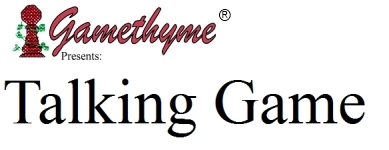As you may or may not know, I spend a lot of time communicating with people about games, and I'm learning more and more what it takes to run a successful game company.
And I couldn't do it - there are just too many things to balance.
For example: What games would I choose to publish? Right out of the gate, Game publishers have to decide whether they are targeting the hardcore or the casual gamer. There are publishers who do both - but you need a starting point, and veering too far from the starting point loses you fans. Asmodee has managed a middle-of-the-road strategy thus far - but they had a head start, as they are France's largest game publisher and had a number of excellent games to choose from.
Even so, were I in charge, I would have made some serious mistakes. For example, I would probably not have published Jungle Speed, which was (arguably) their first US hit.
I also would have passed on Bakong as being "too simple."
Bakong is very simple:
Start by laying out the "board" - basically, make a line of tiles from the starting camp to the Temple and back.
Then roll two dice. Use one die to flip a tile somewhere in front of you and use the other to move. There are hazards which can stop your movement or hurt you. Your move may allow you to pick up one or more emeralds. You may pick up some equipment to ignore one or more of the hazards. Picking up equipment and emeralds fills your backpack, by the way. You don't have room to carry everything you want.
Either way, each turn you have one decision: Which die do I use to flip, and which one is my movement die? If you manage to obtain equipment, it adds the further question, "Which piece of equipment is best for me?"
As soon as you reach the temple, you should take the largest Emerald still there and start back. The emeralds are large and impose some severe limits on space in your pack. In fact, if you have the biggest emerald, you can't fit the best equipment. The biggest emerald also prevents you from healing.
The first player to reach the Temple and return gets a bonus tile. After that, it's a matter of waiting to score.
You score points for Emeralds (the big one you'll have as well as the little ones), and lose points for wounds. Most points wins.
That's it. The game really is that simple.
It's a game that could do well if it found a spot on the shelves at Target or Wal*Mart. That's not to say it's a bad game - because it isn't. It's a very good game, and could very easily become an excellent gateway game, if given a chance.
It also fills a niche that is frequently overlooked by game companies: Games for children. There aren't many games which bridge the gap that falls between Candy Land or Chutes and Ladders and Ticket to Ride or Carcassonne. And most of these gap games aren't likely to be on display at GenCon, as they are mass-market.
Last year, we had some kids come to our booth to play games. The same five kids, over and over and over and over. While they could understand the rules enough to play the games, they just as clearly weren't grasping the strategy involved. This led to games where other people may have gotten negative impressions of a game because of how the kids played. These kids, for the record, were not dumb. They were just young.
If those kids are back this year, I'm gonna try to show them Bakong.
I'm also going to try to sell a copy to my friends Dawn & Jim. I think Eli is about the right age and attention span for this one.

No comments:
Post a Comment